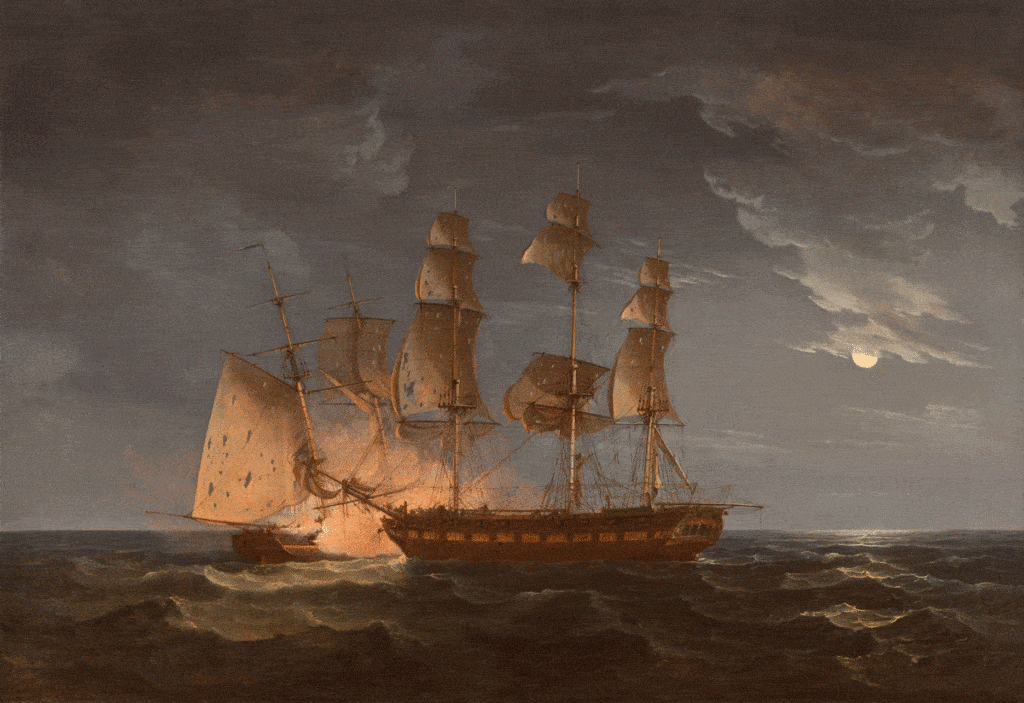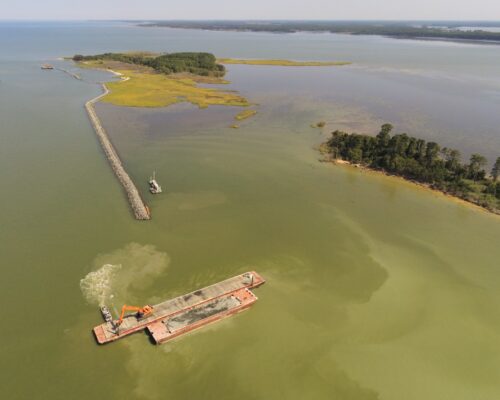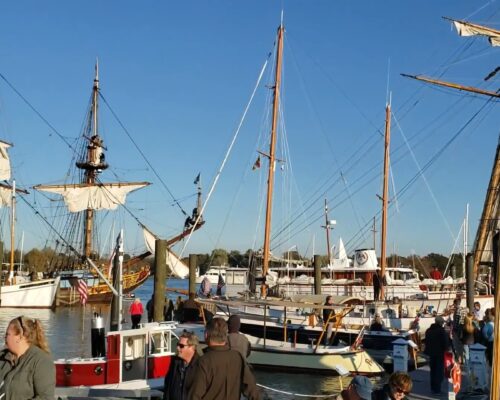Thomas Kemp’s ships took the fight to the British
Top Photo: Fast Baltimore Clippers dot the Baltimore Harbor in this 1869 illustration by E. Sachse, & Co. Credit: Library of congress
During the War of 1812, Baltimore was America’s third largest city, and a center of the country’s shipbuilding industry. One of the leading shipyard owners and builders was Thomas Kemp. His yard at the corner of Washington and Aliceanna Streets in the Fells Point neighborhood produced fast sailing schooners, known for their ability to harass and capture British merchant ships, and to outrun warships. These privateers operated under a government document called a letter-of-marque, giving permission from the American government to disrupt British shipping and enjoy the profits. Without this commission, the sailors would be considered pirates (for more on the real Chesapeake pirates, see page 18). Their crew’s income came entirely from selling off the captured ships and their cargo. It was a risky, but lucrative, business, and big money awaited the owners of the fastest privateers.
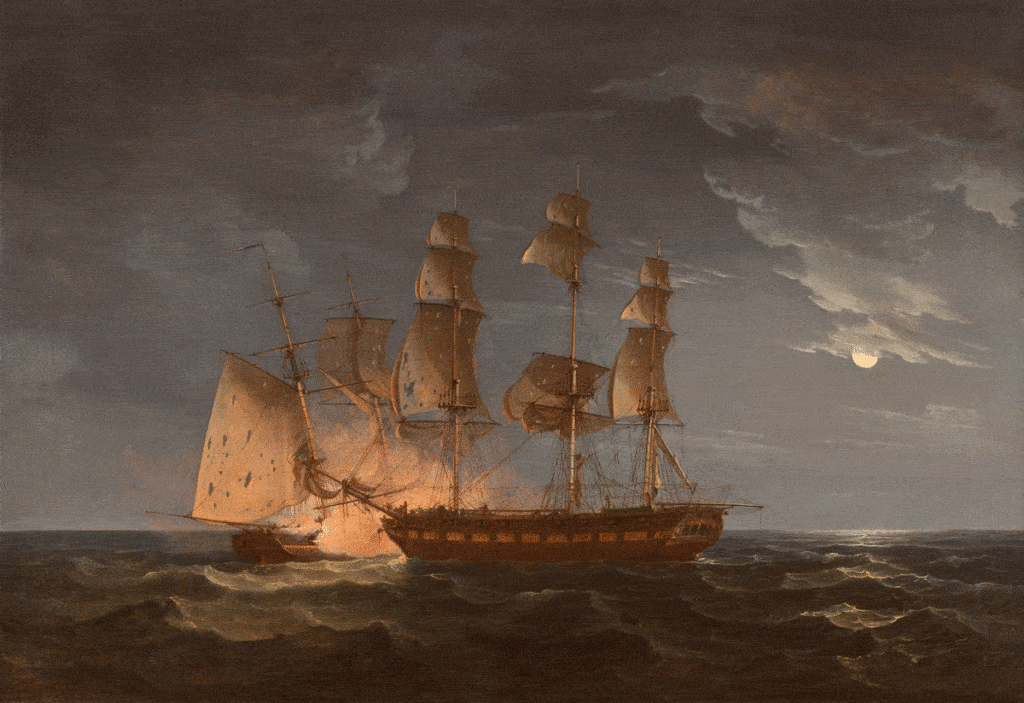
Britain’s navy may have ruled the waves, but it could not begin to protect all of its merchant ships and other trade vessels on the seas around the world. Its blockade of America’s East Coast during the War of 1812 couldn’t stop American shipping either. In the dark of night, Baltimore’s privateers could make a run through the blockade. Baltimore had a well-earned reputation as a center—if not the center—of the American privateering fleet. Approximately 126 privateers operated out of the city during the war, capturing over five hundred British ships and costing the English economy a fortune.
Each week, Baltimore citizens could pick up the Niles’ Weekly Register and read a list of privateers and their “American prizes,” British ships that privateer crews had captured. The privateers Thomas Kemp built were usually on the list. Kemp gained a national reputation because his yard built the four most celebrated privateers in the country: the Rossie, the Rolla, the Comet and the Chasseur (dubbed the “Pride of Baltimore”). Between the four ships they seized prizes worth millions of dollars.
Privateers usually earned pure profit after one or two voyages. Their owners could make a lot of money from the sale of prizes (the captured ships and goods). Half the profits went to the owners, the other half to the officers and crew. A large crew was necessary, to sail captured enemy ships to port.
Though generally equipped with some guns, these vessels were built to run, not fight. A privateer would stalk British ships on trade routes or lie in wait near hostile or neutral ports. Once an enemy ship was spotted, the chase began. When the ship was captured, the American captain would commandeer it and either sail it to a neutral port or to the United States, or confiscate the goods and sink it. The sailors on the captured ship were imprisoned and either exchanged or ransomed for money. To add to the challenge, not all captured ships were successfully sent to port. Many of these prizes were recaptured by the British blockaders as they tried to enter U.S. ports.
What made the Baltimore privateers so successful? Kemp and other Baltimore shipbuilders were some of the most creative ship designers in America. They had figured out a unique design that allowed ships to move fast and maintain agility. According to Captain Jan Miles of the replica schooner Pride of Baltimore II, “there was a boldness in the construction of Baltimore’s ships.” No two ships were exactly alike. With each new ship, designers and builders attempted to find the right combination of design elements that made the ships faster and faster. Kemp had an office in his house near the shipyard where he labored over his plans. His design increased speed by adding sails in topmasts, to catch the wind higher above the deck.
Despite their differences, the ships all featured similar elements. Shape contributed to effectiveness. The V-shaped hull could easily cut through water. The schooners had what was called a sharp hull below the water that allowed them to sail closer to the wind (toward the direction from which the wind comes). The masts were raked, or angled back, to further increase speed. To overcome water resistance, the ships had a large sail area with many topsails. Schooners made very efficient use of space for sails to capture as much wind as possible.
Aside from the sleek design, a key element to a privateer’s success was a skillful and daring captain. One of the most famous was Thomas Boyle. A native of Marblehead, Massachusetts, a town surrounded by water, Boyle went to sea at age ten, and by 16 was sailing master of a ship, responsible for its navigation. At 19, he moved to Baltimore and with the success of the privateers under his control, he soon became famous. He commanded two ships built in the Kemp shipyard, the Comet and the Chasseur.
American privateer crews sometimes ventured across the Atlantic Ocean, capturing ships in the enemy’s waters. According to the book The Old Merchant Marine, published in 1919, an English newspaper declared outrage that “a horde of American cruisers should be allowed, unresisted and unmolested, to take, burn, or sink our own vessels in our own inlets and almost in sight of our own harbors.”
In August 1814, Thomas Boyle and the brig Chasseur boldly sailed into the English Channel. To the shock of the British public, he sent a captured British sailor to attach a written pronouncement to the door of Lloyd’s Coffee House in London, then center of the British insurance industry, a famous haunt of sailors. It proclaimed that all of Britain was under a total blockade, an action he could in no way enforce. But to the wonder of all, Boyle captured fourteen British merchant ships during this three-month voyage, returning to Baltimore even more famous than when he left. On his return, the guns of Fort McHenry saluted him and crowds on Federal Hill cheered him.
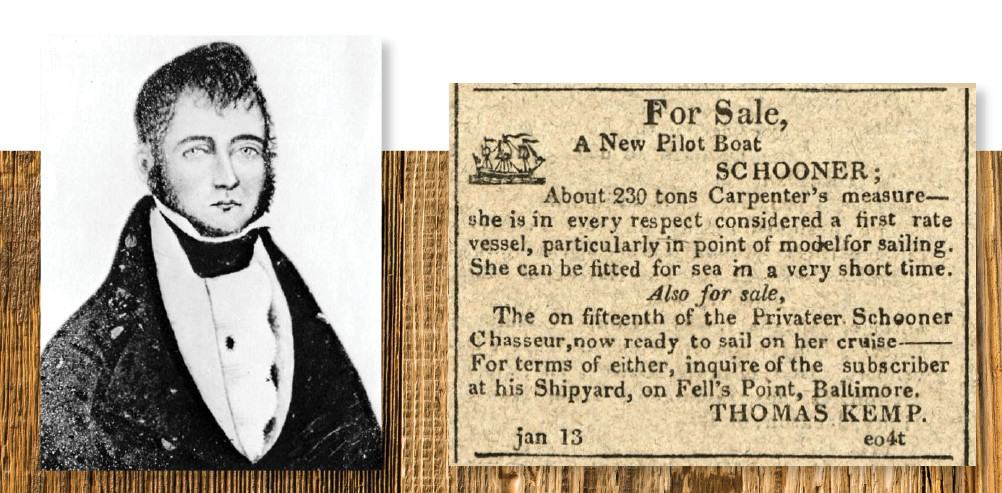
Building a ship was like putting a puzzle together and required men with many types of skills. Kemp’s shipyard employed two dozen men, mostly carpenters and caulkers, who sealed the cracks between boards and ensured the ship’s seaworthiness. He also hired blacksmiths, riggers (who set all the ropes, wires, and chains controlling the sails and masts) and expert shipwrights. He needed to buy all kinds of supplies too, including timber, spars (wooden poles), beams, iron work, copper spikes and rivets, rosin, and pitch. Surrounding the shipyards in Fells Point were many businesses, called chandleries, that sold supplies needed for the ships: block and tackle, pump, rope, and sails. In several nearby long, narrow buildings called ropewalks, men twisted hemp into the miles of rope needed to rig Baltimore’s ships.
The most famous ship built at Fells Point was Kemp’s masterpiece, the Chasseur (meaning “hunter” in French). It measured 116 feet long with a 26 foot-beam (35.35 x 7.92 meters) and launched in December 1812. No contemporary picture of her exists, but Hezekiah Niles, editor of the Niles’ Weekly Register, wrote at the time “she was indeed a fine specimen of naval architecture, and perhaps the most beautiful vessel that ever floated on the ocean. She sat as light and buoyant on the water as a graceful swan, and it required but very little imagination to feel that she was about to leave her watery element, and fly into the clear, blue sky.”
The Chasseur’s original owner hired Kemp to build a trading vessel, not a privateer. After several unsuccessful years in trading, its owner put the ship up for auction.
Kemp was one of 17 men who came together to purchase the Chasseur with plans to transform it from a fast trade vessel into an even faster privateer. They added cannons, hired a crew, and appointed a captain. The Chasseur sailed to the Caribbean, then to Europe.
Thomas Kemp had grown up surrounded by ships. His ancestors, from Yorkshire in England, settled on the Eastern Shore of the Chesapeake Bay in 1678. This was an area of never- ending sea grasses and mud flats, where the constant rising and falling of the tides had carved a jagged edge of inlets and coves. The Kemp home sat near the town of St. Michaels, Maryland, which was fast developing into a shipbuilding center. Young Thomas would have heard pounding hammers and creaking beams as shipwrights carved and molded giant pieces of timber into large ships. Perhaps the sights and sounds got into his blood and spurred him on his career path. When he grew older, Thomas served as an apprentice at one of these shipyards.
In 1803, he decided to seek his fortune away from the Eastern Shore. He moved to Baltimore to practice his newly acquired trade. He found work in the shipyard of Joseph Sterett that first year. The Sterett shipyard had built the U.S. Frigate Constellation, the second warship in the American Navy.
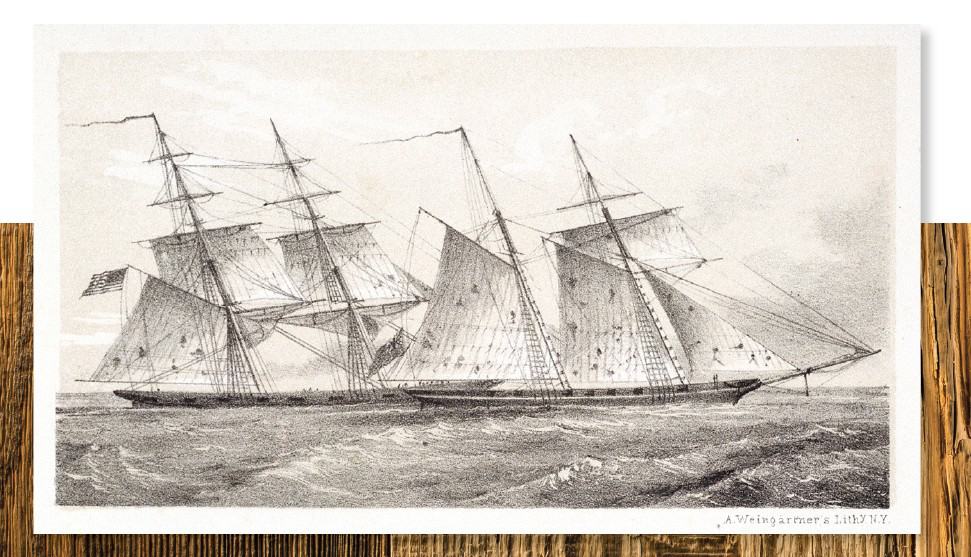
Photo Credit: National Maritime Museum, Greenwich
Kemp married Sophia Horstman and purchased a house on the corner of Market and Lancaster streets from his father-in-law. During his first two years in Baltimore he mostly repaired vessels. But he was eager to start designing and building his own ships. In 1804, he and his brother Joseph built the Thomas and Joseph schooner, considered the first Thomas Kemp-designed schooner.
By 1805, at age 26, Kemp had saved enough money to establish his own shipyard. He purchased land at Washington and Aliceanna streets and in 1807 he began designing and building ships, almost exclusively Baltimore schooners. Even the United States Navy sought his expertise. His yard built two ships for the Navy, the U.S.S. Erie and the U.S.S. Ontario. Kemp also crafted the masts and spars for the nearly-complete frigate Java. Business was soon thriving. Kemp’s weekly payroll was $1,000 (at a time when skilled workmen earned about $3 per day). An astute businessman, Kemp often bought shares of ownership in the privateers his yard built. Many shipbuilders did this as an investment and to help ensure future repair contracts.
Business was so good that in May 1814, he purchased a 170-acre estate in Baltimore called Lovely Green. He guessed that if the British attacked and captured Baltimore, they would most assuredly set fire to the shipyards and possibly confiscate his home. Everything Kemp had worked so hard for could go up in flames. Yet Kemp’s success was a major reason why the British hated Baltimore.
After a three-day attack, the British failed to capture Baltimore, thanks to the defenders at Fort McHenry and Hampstead Hill (present-day Patterson Park). Today the spirit of Kemp and the privateers lives on in the Pride of Baltimore II, a reproduction tall ship docked in the city for much of the year. Built in Baltimore’s Inner Harbor in 1988 after the original Pride reproduction was tragically lost at sea, Pride II was officially commissioned in Fells Point, just yards away from Kemp’s historic shipyard where the Chasseur was built. While not an exact copy of the Chasseur, they share various features. Pride has sailed to over 200 ports around the world, an ambassador of Baltimore’s rich maritime heritage. It is an educational showcase, highlighting the days when Baltimore ships held a national reputation for their speed and agility—and, as the troublemakers of the waves.
Adapted from Star-Spangled: The Story of a Flag, a Battle, and the American Anthem, Abrams Books for Young Readers, 2020.

